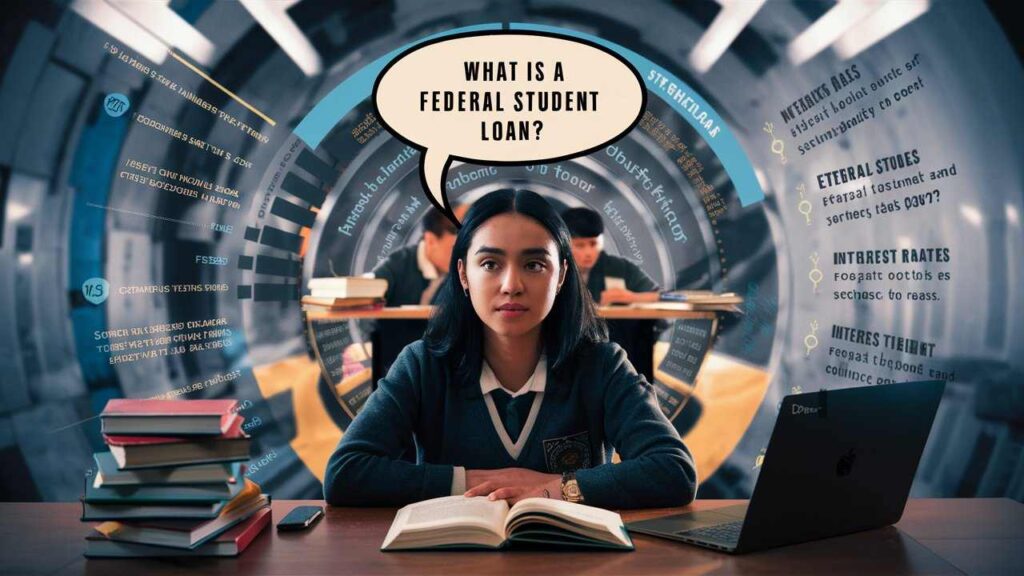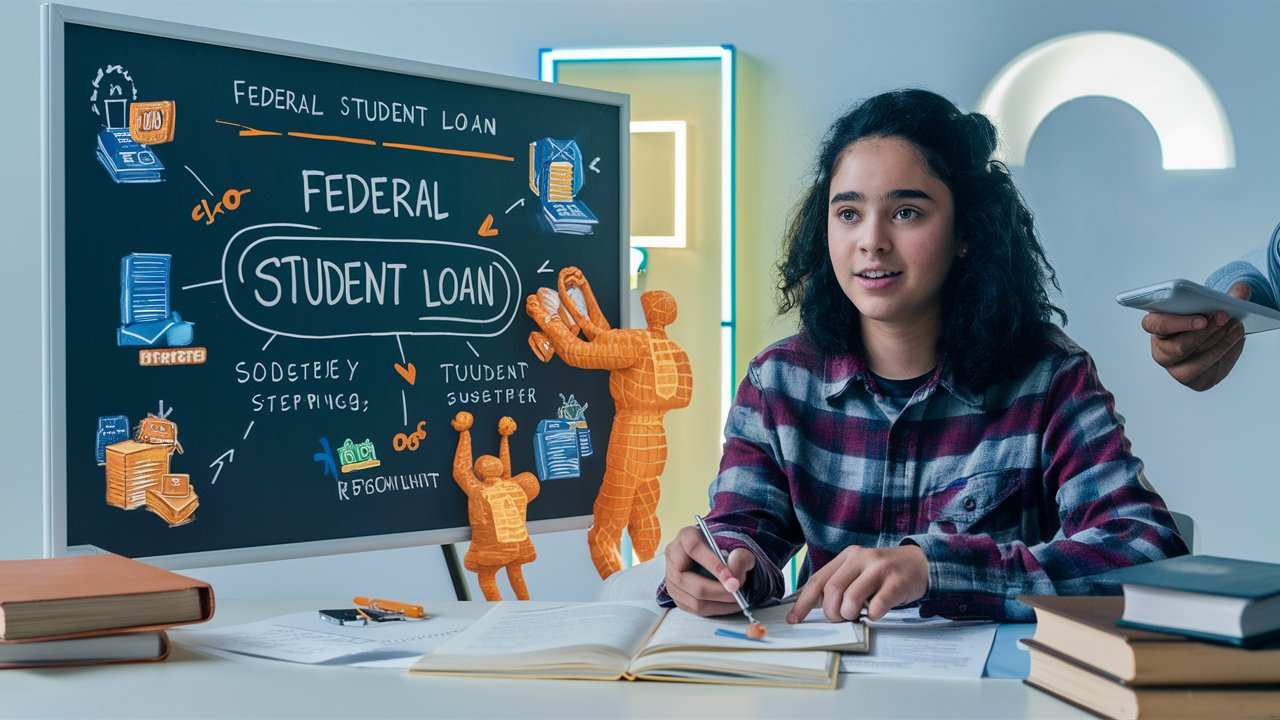Navigating the Federal Student Loan Universe
Welcome to the thrilling rollercoaster of Federal Student Loans! If you’re a student or a parent navigating the financial labyrinth of higher education, you’re in the right place. Federal Student Loans are often the ticket to unlocking the door to college, but understanding them can feel like deciphering ancient runes. Fear not! This guide will demystify Federal Student Loans and set you on the path to financial enlightenment.

What Exactly is a Federal Student Loan?
A Federal Student Loan is a financial aid option provided by the government to help students pay for their education. Unlike private loans, these loans come with a set of perks like lower interest rates and flexible repayment options. Essentially, it’s like having a fairy godmother who doesn’t mind your GPA but does care about your ability to pay back the money with a bit of interest.
Types of Federal Student Loans:
Which One Fits Your Needs?
Federal Student Loans aren’t one-size-fits-all. They come in various flavors:
- Direct Subsidized Loans: For undergraduates with financial need. The government pays the interest while you’re in school.
- Direct Unsubsidized Loans: Available to undergrads and grads. Interest accrues from the moment the loan is disbursed.
- Direct PLUS Loans: For parents of undergraduates and graduate students. No financial need required, but a credit check is involved.
- Direct Consolidation Loans: Allows you to combine multiple federal loans into one for easier management.

Understanding Subsidized vs. Unsubsidized Loans: The Key Differences
Subsidized and unsubsidized loans are like the two sides of a coin. Subsidized loans have the charm of government-covered interest while you’re in school and during deferment periods. Unsubsidized loans, on the other hand, start accruing interest immediately. The choice between them could depend on your financial situation and how much interest you’re willing to accrue.
How to Get Your Hands on Federal Funds
Getting your hands on Federal Student Loans requires a few crucial steps:
- Complete the FAFSA: The Free Application for Federal Student Aid is your golden ticket.
- Review Your Aid Offer: After submission, you’ll receive a financial aid offer from your school detailing your loan amounts.
- Accept the Loan: Decide which loans to accept and sign your promissory note.
Eligibility Requirements: Who Qualifies for Federal Student Loans?
To qualify for Federal Student Loans, you must be a U.S. citizen or eligible non-citizen, have a valid Social Security number, and be enrolled at least half-time in an eligible program. Financial need plays a role for some types of loans, but others are available regardless of financial status.

How to Apply: Filling Out the FAFSA Like a Pro
The FAFSA is your gateway to Federal Student Loans. To ace the application:
- Gather Documents: Have your tax returns, W-2s, and bank statements ready.
- Create an FSA ID: This unique identifier will let you sign your FAFSA electronically.
- Fill Out the FAFSA: Complete it online at the official FAFSA website and submit it before the deadline.
Loan Limits: How Much Can You Borrow and When?
Federal Student Loan limits are set annually and depend on your year in school and dependency status. For undergraduates, the limits range from $5,500 to $12,500 per year. Grad students and parents can borrow more, but there are caps on the total amount that can be borrowed throughout your academic career.
Interest Rates: What to Expect and How They Are Set
Federal Student Loan interest rates are fixed and set by Congress. They are usually lower than private loans and can vary based on the loan type and the year you borrow. Rates for subsidized and unsubsidized loans are generally lower than for PLUS loans. Stay updated on the current rates to understand how much you’ll be paying.
Repayment Plans: Finding the Right Fit for Your Financial Situation
Repaying Federal Student Loans doesn’t have to be a nightmare. There are several plans:
- Standard Repayment Plan: Fixed monthly payments over 10 years.
- Graduated Repayment Plan: Payments start low and increase over time.
- Extended Repayment Plan: Longer repayment term with fixed or graduated payments.
Choose the plan that aligns with your financial situation and long-term goals.
Income-Driven Repayment Plans: The Benefits of Flexibility
Income-driven repayment plans adjust your monthly payment based on your income and family size. These plans can make payments more manageable if you’re struggling financially. Options include:
- Income-Based Repayment (IBR)
- Pay As You Earn (PAYE)
- Revised Pay As You Earn (REPAYE)
- Income-Contingent Repayment (ICR)
These plans can help ensure your payments are proportional to your earnings.
Loan Forgiveness Programs: Can Your Debt Disappear?
Yes, some Federal Student Loans may be eligible for forgiveness under specific conditions. Public Service Loan Forgiveness (PSLF) and Teacher Loan Forgiveness are notable programs that forgive loans after a certain period of qualifying payments and service. Understand the requirements and see if you might qualify.
How to Manage Your Loans: Tips for Keeping Track
Managing student loans is crucial for financial health. Here’s how to stay on top:
- Keep Detailed Records: Track your loans, balances, and repayment status.
- Make Payments on Time: Avoid late fees and potential damage to your credit score.
- Use a Loan Management Tool: Apps and online tools can help track and manage payments.
Deferment and Forbearance: When to Hit Pause on Payments
Deferment and forbearance allow you to temporarily stop making payments without defaulting. Deferment is often available for financial hardship, while forbearance is typically granted when you’re experiencing temporary financial difficulties. Understand the implications of each, as interest may still accrue.
The Impact of Federal Student Loans on Your Credit Score
Federal Student Loans can affect your credit score, especially if payments are missed. On-time payments can positively impact your credit, while missed payments or defaults can have the opposite effect. Managing your loans responsibly helps build a solid credit history.
Loan Consolidation: Streamlining Your Student Debt
Consolidating your Federal Student Loans combines multiple loans into a single loan with one monthly payment. This can simplify repayment and potentially lower your monthly payment. However, be aware of potential downsides, like loss of certain borrower benefits.
Refinancing Options: Is It Worth It for Federal Loans?
Refinancing Federal Student Loans with a private lender may offer lower interest rates or different terms, but it also means losing federal loan benefits like income-driven repayment plans and loan forgiveness options. Weigh the pros and cons carefully before deciding to refinance.
Common Pitfalls: Mistakes to Avoid with Federal Student Loans
Avoid these common pitfalls:
- Missing Payments: Leads to late fees and potential damage to your credit.
- Ignoring Loan Terms: Understanding your loan terms is crucial.
- Not Utilizing Repayment Plans: Explore options that might better suit your financial situation.
How to Appeal a Loan Decision: What to Do If Things Go South
If your loan application is denied or you face issues, you can appeal the decision. Contact your loan servicer for guidance and provide any additional documentation required. It’s important to address issues promptly to avoid complications.
Preparing for Repayment: Getting Ready for the Post-Graduation Grind
Before graduation, start planning for loan repayment:
- Know Your Loan Details: Understand your loan amounts, servicers, and repayment terms.
- Create a Budget: Incorporate your loan payments into your post-graduation budget.
- Set Up a Payment Plan: Choose a repayment plan that aligns with your financial situation.
Success Stories: How Others Have Mastered Their Student Loan Debt
Explore how others have successfully managed their student loans. From aggressive repayment strategies to taking advantage of forgiveness programs, these stories can provide inspiration and practical tips.
Conclusion:
Embracing Your Federal Student Loans with Confidence
Federal Student Loans are a powerful tool for funding education but managing them wisely is essential. With the right knowledge and strategies, you can navigate the repayment process and achieve financial success.
Final Thoughts: Turning Your Loan Knowledge into Financial Success
Understanding Federal Student Loans is just the beginning. Applying this knowledge to manage and repay your loans effectively will set you on a path to financial stability and success. Embrace the journey with confidence and keep informed about your options.
Frequently Asked Questions (FAQs)
How do I apply for a Federal Student Loan?
To apply for a Federal Student Loan, you need to complete the Free Application for Federal Student Aid (FAFSA). This form determines your eligibility for federal financial aid and can be submitted online at the official FAFSA website. Make sure to have your financial documents handy to complete the application accurately.
What are the different types of Federal Student Loans?
Federal Student Loans come in several types:
- Direct Subsidized Loans: For undergraduates with financial need; the government pays the interest while you’re in school.
- Direct Unsubsidized Loans: Available to undergraduates and graduates; interest accrues from the disbursement date.
- Direct PLUS Loans: For parents of undergraduates and graduate students; requires a credit check.
- Direct Consolidation Loans: Allows you to combine multiple federal loans into one.
What is the difference between subsidized and unsubsidized Federal Student Loans?
Subsidized loans have the advantage of the government covering the interest while you’re in school and during deferment periods. Unsubsidized loans start accruing interest immediately, which you are responsible for paying even while in school.
How do I check my Federal Student Loan balance?
To check your Federal Student Loan balance, log in to your account on the Federal Student Aid website. You can view detailed information about your loans, including the current balance, payment history, and loan servicer contact information.
What is the Federal Student Loan interest rate?
Federal Student Loan interest rates are set annually by Congress and can vary based on the type of loan and the year it was borrowed. For current rates, visit the Federal Student Aid website or check recent Federal Student Loan announcements.
How do I consolidate my Federal Student Loans?
To consolidate your Federal Student Loans, apply for a Direct Consolidation Loan through the Federal Student Aid website. This process combines multiple federal loans into one, potentially simplifying repayment and extending the repayment term.
What is the process for repaying Federal Student Loans?
Repayment of Federal Student Loans begins after a six-month grace period following graduation or dropping below half-time enrollment. Choose a repayment plan that fits your financial situation and start making monthly payments. Manage your account through your loan servicer’s website.
Are there any Federal Student Loan forgiveness programs?
Yes, there are several Federal Student Loan forgiveness programs, including Public Service Loan Forgiveness (PSLF) and Teacher Loan Forgiveness. These programs can forgive a portion or all of your Federal Student Loan debt after meeting specific requirements.
How do I apply for Federal Student Loan forgiveness?
To apply for Federal Student Loan forgiveness, ensure you meet the eligibility criteria for the specific program. For Public Service Loan Forgiveness, for example, submit the Employment Certification Form annually and apply for forgiveness after making 120 qualifying payments.
What are the income-driven repayment plans for Federal Student Loans?
Income-driven repayment plans adjust your monthly payment based on your income and family size. Plans include:
- Income-Based Repayment (IBR)
- Pay As You Earn (PAYE)
- Revised Pay As You Earn (REPAYE)
- Income-Contingent Repayment (ICR)
These plans can make payments more manageable based on your financial situation.
How can I defer my Federal Student Loans?
To defer your Federal Student Loans, you must apply for deferment through your loan servicer. Deferment may be granted for reasons such as financial hardship, unemployment, or continuing education. Interest may still accrue depending on the loan type.
What happens if I default on my Federal Student Loans?
Defaulting on Federal Student Loans can lead to serious consequences, including damaged credit, wage garnishment, and the loss of eligibility for additional federal financial aid. It’s important to address defaults quickly by contacting your loan servicer and exploring options such as rehabilitation or consolidation.
Can Federal Student Loans be discharged in bankruptcy?
Federal Student Loans are generally not dischargeable in bankruptcy except in cases of extreme financial hardship. To qualify, you must prove undue hardship, which is a high standard to meet. For more information, consult with a bankruptcy attorney.
How do I find out who services my Federal Student Loans?
To find out who services your Federal Student Loans, log in to your account on the Federal Student Aid website. Your loan servicer’s contact information, along with details of your loan accounts, will be available.
What are the eligibility requirements for Federal Student Loans?
Eligibility requirements for Federal Student Loans include being a U.S. citizen or eligible non-citizen, having a valid Social Security number, and being enrolled at least half-time in an eligible program. You must also demonstrate financial need for some types of loans.
How does a Federal Student Loan impact my credit score?
Federal Student Loans can impact your credit score based on your payment history. On-time payments can positively affect your credit, while missed or late payments can damage it. Proper management of your loans is key to maintaining a good credit score.
What is the Public Service Loan Forgiveness program?
The Public Service Loan Forgiveness (PSLF) program forgives remaining Federal Student Loan debt after 120 qualifying payments while working full-time for a qualifying public service organization. This program is designed for individuals in government or non-profit sectors.
How do Federal Student Loans affect my tax return?
Federal Student Loans can impact your tax return through potential deductions and credits. For example, you may be able to deduct student loan interest paid on your federal income tax return. Keep track of your loan interest payments and consult with a tax professional for details.
How do I change my repayment plan for Federal Student Loans?
To change your repayment plan, contact your loan servicer and request a switch to a different plan. You can select from various repayment options based on your financial situation. Your servicer will guide you through the process of updating your plan.










